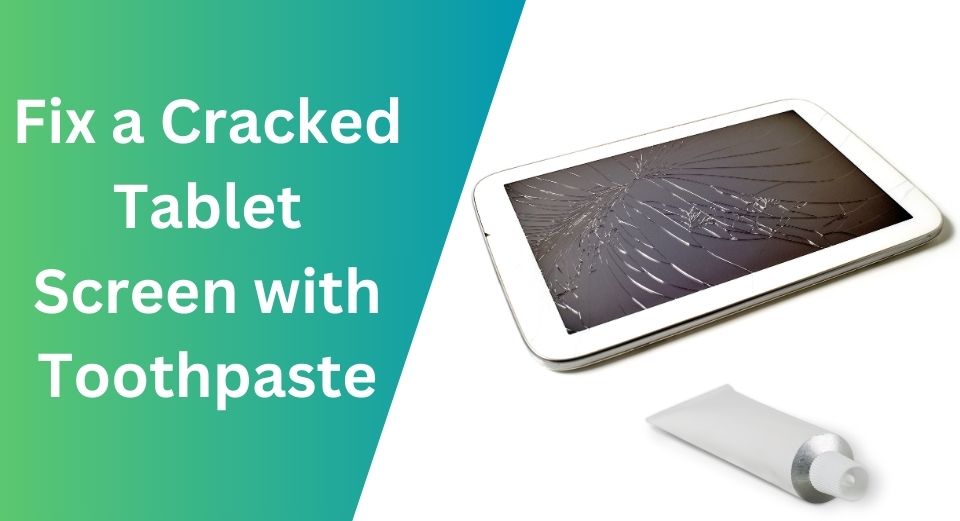We’ve all been there – that heart-stopping moment when your beloved tablet takes a tumble and its screen ends up looking like a spiderweb. It’s frustrating, right? But here’s a quirky solution that might just surprise you: toothpaste! Yes, you read that right. In this guide, we’ll walk you through the steps of how to fix a cracked tablet screen with toothpaste. So, let’s roll up our sleeves and dive into this unconventional yet intriguing DIY adventure!
Understanding the Damage
Before we start, let’s get real about the damage. Cracked tablet screens come in all shapes and sizes, from minor hairline fractures to those epic shatters that make us cringe. Toothpaste might not be a magical cure for all scenarios, but it could work wonders for those smaller cracks that are more of an eyesore than a hindrance to functionality. If your screen is hanging on by a thread (literally), it might be best to explore professional repair options.
Read More: How to Clean a Drawing Tablet?
Toothpaste as a Repair Solution: Myth or Reality?
Now, you might be wondering, “Toothpaste? Seriously?” For tiny dents, toothpaste may work well because it is mildly rough and has smoothing properties. It won’t magically fuse your screen back together or erase massive cracks. So, manage your expectations and consider this approach if the damage is minimal.
Materials Needed
First things first, let’s gather our makeshift toolkit. You’ll need toothpaste (yes, the kind you use for your teeth), a microfiber cloth, tape, and a screen protector. Each of these items plays a crucial role in the toothpaste repair process – toothpaste for its abrasive properties, microfiber cloth for polishing, tape for temporary fixes, and a screen protector for future protection.
How to fix a cracked tablet screen with toothpaste? Step-by-Step Repair Guide
- Prepare the Tablet: Turn off your tablet and clean the screen thoroughly to remove any dirt or smudges. A clean surface is essential for the toothpaste to work effectively.
- Apply Toothpaste: Choose a white, non-gel toothpaste and apply a small amount directly to the cracked area. Remember, a little goes a long way.
- Spread the Toothpaste: Gently use your fingertip or a cotton swab to spread the toothpaste over the crack in circular motions. The idea is to work the toothpaste into the crack and cover it evenly.
- Let It Sit: Allow the toothpaste to dry and harden. This might take about 15-20 minutes. It’s like giving your tablet a mini spa treatment!
- Polish the Screen: Grab your microfiber cloth and gently polish the screen in circular motions. This step helps to remove excess toothpaste and leaves your screen looking cleaner.
- Temporary Fix with Tape: If your crack is minor, you can use transparent tape to hold the pieces together temporarily. It’s not a permanent solution, but it can take you some time.
- Long-Term Prevention: Apply a screen protector to prevent future mishaps. It won’t protect against all accidents, but it’s an extra layer of defence.
Maintenance and Preventive Measures
Congratulations on successfully giving your tablet a DIY spa day! Now, let’s talk about keeping that screen in tip-top shape and preventing future cracks. Here’s how:
- Regular Cleaning: Use a microfiber cloth to gently wipe the screen regularly. This removes fingerprints, dust, and smudges without scratching the surface.
- Avoid Harsh Materials: Never use abrasive materials like paper towels or rough cloths to clean your screen. These can cause micro-scratches over time.
- Tablet Case: Invest in a quality tablet case. A shock-absorbent case can provide a cushion against accidental drops, reducing the risk of cracks.
- Screen Protector: Applying a screen protector is like giving your tablet armor. It won’t make your tablet invincible, but it adds an extra layer of protection against scratches and minor impacts.
- Handle with Care: Treat your tablet like the delicate piece of technology it is. Avoid placing heavy objects on top of it and handle it gently to prevent unnecessary stress on the screen.
- Avoid Extreme Temperatures: Extreme heat or cold can damage the internal components of your tablet, potentially leading to screen issues. Keep your tablet at a moderate temperature range.
- Secure Storage: When not in use, store your tablet in a safe and secure place to avoid accidental drops or impacts.
You can also check: How to fix a Samsung tablet stuck on the charging screen?
Risk of repairing tablet screen with toothpaste
While using toothpaste as a DIY solution to repair a cracked tablet screen might seem like a convenient and cost-effective option, it’s important to be aware of the potential risks involved. Here are some risks to consider before attempting this method:
1. Limited Effectiveness:
Toothpaste is not designed specifically for repairing screens. Its abrasive properties might help with minor scratches, but it won’t work miracles on significant cracks or shattered screens.
2. Further Damage:
Using toothpaste incorrectly could lead to more harm than good. If you apply too much pressure or use an abrasive toothpaste, you might end up scratching the screen further or damaging the touchscreen functionality.
3. Voided Warranty:
Most tablets come with manufacturer warranties, and attempting DIY repairs, especially unconventional ones like using toothpaste, could void your warranty. If your tablet is still under warranty, it’s better to explore official repair options to avoid future complications.
4. Inconsistent Results:
The outcome of using toothpaste can vary greatly depending on factors like the type of toothpaste used, the severity of the crack, and the tablet’s screen material. There’s no guarantee that the repair will be successful or aesthetically pleasing.
5. Unpredictable Chemical Reactions:
Different toothpaste brands contain various ingredients. Some toothpaste might have chemicals that could react with the tablet screen’s coating or materials, causing unexpected discoloration or damage.
6. Temporary Fix:
Even if toothpaste manages to make the crack less noticeable, it’s often a temporary solution. Over time, the toothpaste might wear off, and the crack could become more prominent again.
7. DIY Risks:
Repairing electronics without proper tools and expertise can lead to accidental damage. Disassembling the tablet or applying pressure in the wrong areas might cause irreversible harm to internal components.
And there you have it, folks – a guide on how to fix a cracked tablet screen with toothpaste. While it might sound odd, toothpaste’s abrasive properties can work their magic on those minor cracks, giving your tablet a second chance at looking its best. Just remember, this is a DIY solution, and professional help is the way to go for more serious damage. So go ahead, give your tablet some toothpaste love, and see the results for yourself!




